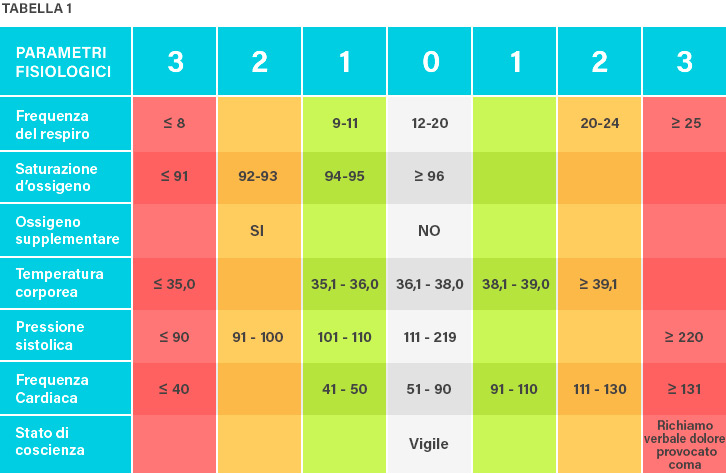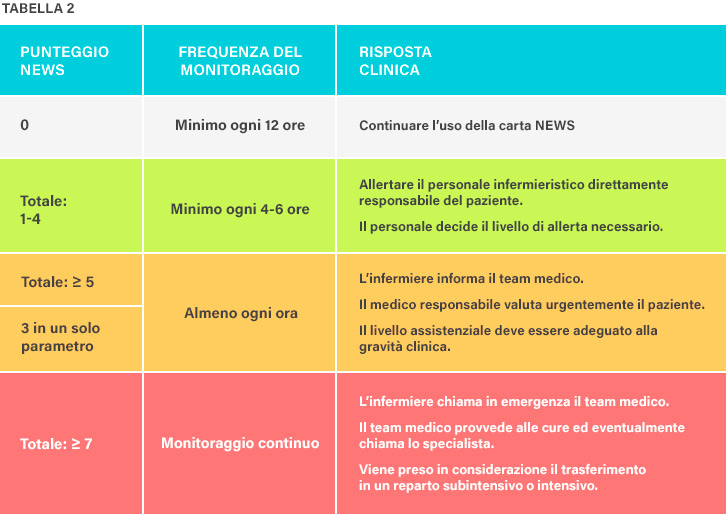N.E.W.S.
index
The instrument developed by the international scientific community as a preventive indicator of the degradation of patients' conditions
Cosa è
l'indice N.E.W.S.
In the last decade, research in the clinical and health care fields has focused on finding standard methods to evaluate and improve 3 important factors:
1) Recognise early deterioration
of the patient's conditions
2) Create procedures that are standard, secure and timely for treatment
3) Increase the quality of patient care
All this derives from certain studies, which began in 2006, carried out by the British health agency NCEPOD, which indicated that the time interval from the onset of clinical deterioration and the patient being transferred to an intensive care unit was too long.
The conclusion that ensued was that a considerable number of deaths would be avoided by improving the inadequate healthcare situations.
For this purpose, many versions of a simple monitoring tool of the vital functions were designed - the so-called EWS: Early Warning Score. The concept underlying EWS is the collection of vital parameters in a score that provides a clear, standard and easy to understand index in order to implement a preset and standardised clinical response.
In 2012 the Royal College of Physicians (RCP) developed and drafted a National EWS, intended to be shared by all healthcare services and which forms part of the Italian regional directives - the N.E.W.S..
Using
del N.E.W.S.
The appropriate medical staff (nurses in hospital) measure 6 vital parameters:
→ Respiratory rate
→ Heart rate
→ Body temperature
→ Systolic pressure
→ State of consciousness
→ Oxygen saturation
A number is assigned for each parameter in the result of the measurements, according to Table 1.

The sum of the individual scores determines the value of N.E.W.S., which is the index of severity of the clinical conditions. Depending on the measured N.E.W.S. value, the clinical responses described in Table 2 must be implemented.
The hourly rate of the measurements indicated in the N.E.W.S. tool is one of the key factors to guarantee the monitoring effectiveness and therefore of the treatment given.

The texts of the regional directives and the reports of the healthcare facilities that are in charge of covering this topic emphasise on the convenience of the EWS instrument and particularly on how it must be standardised and its use must facilitate and speed up the routine work of hospital staff. Its use is also vastly promoted in order to improve the quality of the facility system and therefore attributes a value of prestige to it.
All this is very true, but if the cost is analysed in terms of time and staff to implement the N.E.W.S. with current technology, it is no wonder if it is not as prevalent or in any case it does not fit precisely in the procedures of the hospital wards. The primary workload is not determined by calculating the index but by measuring the vital parameters. In a medium-sized hospital ward (about 40 beds/patients), approximately 10 minutes per patient are required to measure the parameters for the N.E.W.S., log them in the PC and run the calculation, which equals to a total of 6 hours. For successful implementation, this requires 1 nurse (at least) per turn to be dedicated to this activity, with its business cost.
SiMews was specifically created to surpass this limit
According to us, the process and purpose behind the idea of the N.E.W.S. system is very serious and important, and this is why we became interested in developing a wearable biomedical instrument, which is easy to use that measures the vital parameters, attributes various scores, determines the severity index and sends the information to a monitor in the nurse station and with an immediate colour code describes the condition of the patients in the ward.The advantages in terms of staff costs, internal organisation and reliability of the measurements are easy to imagine. The parameters of N.E.W.S. must no longer be measured manually, patient by patient, but are collected automatically without the intervention of nurses or other specialist staff.
